Last Updated on April 4, 2024
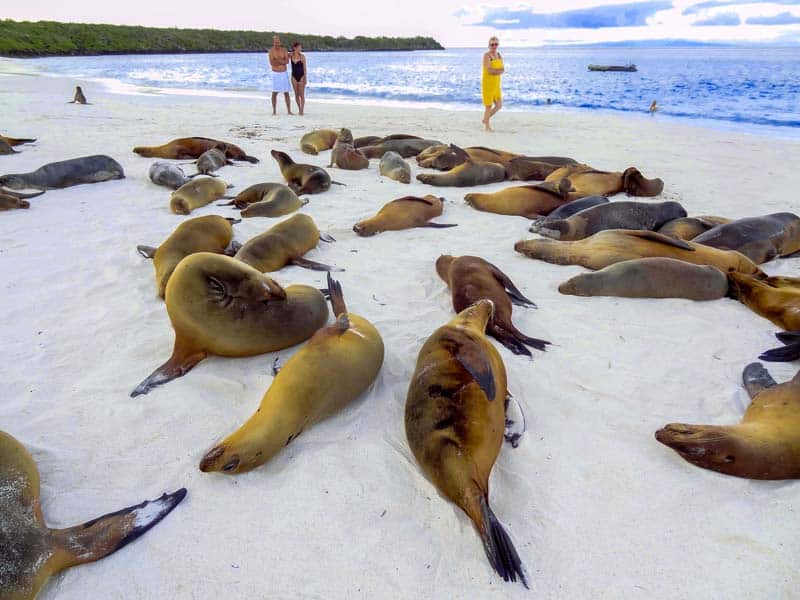
By Jim Ferri
A Galapagos cruise vacation is a trip of a lifetime for many people. If you haven’t yet visited the islands, it’s one of those places you need to put on your “must-travel-to” list.
Like many travelers, I’d wanted to take a Galapagos cruise vacation for years. My fascination with the islands began after photos of them in National Geographic set the hook in my childhood mind. They’ve fascinated me ever since.
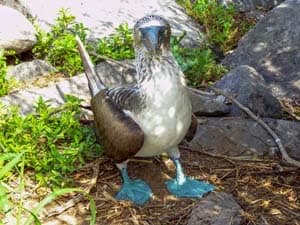
Formed by volcanoes in the Pacific about 600 miles (970 km) off the coast of Ecuador, they’re situated on the equator at the meeting point of several large oceanic currents. It’s these currents, among other things, have helped make the islands a Jurassic Park of sorts.
The Galapagos were first made famous by Charles Darwin, who wrote his theory of evolution after visiting there in 1835.
The islands have greatly surged in popularity in recent decades. They now lure thousands each year since they’re a place where you find species unlike any other in the world.
There are sea lizards that look like little dragons…birds with blue or red feet…albatrosses with eight-foot wingspans…gigantic 100+-year-old tortoises weighing more than 500 pounds… Thankfully, the islands are a UNESCO World Heritage Site, which affords them some protection in our 21st-century world.
To its credit, the Ecuadorian government is also providing protection, placing strict controls on visits to the islands. This includes limiting where any tour company can go on a specific day. This works well since you no longer have four ships dumping hundreds of people onto the same strip of beach. And you also don’t encounter other tour groups during day-hikes through the interior.
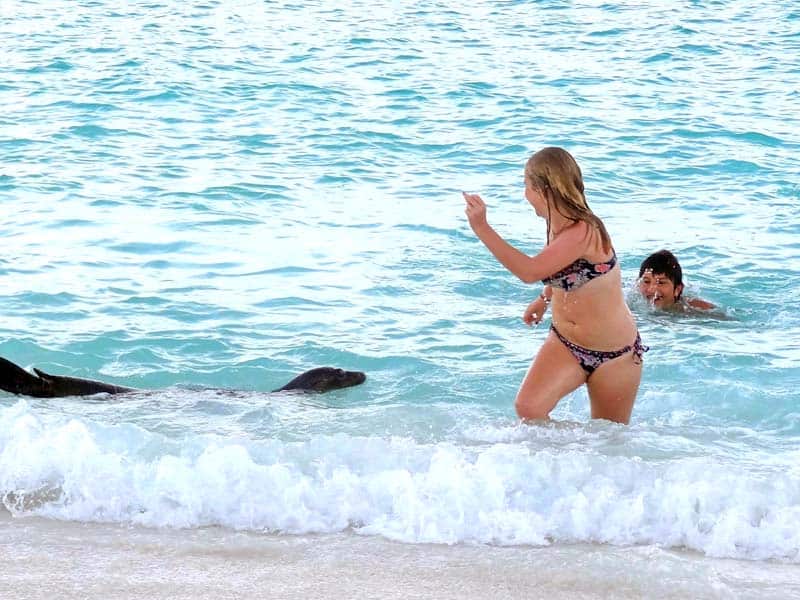
The Best Thing About A Vacation in the Galapagos
The best thing about a Galapagos cruise vacation is that you can get quite close to the animals since they have no fear of humans. On one of our hikes, a bird landed on one woman’s head when we stopped to listen to the naturalist. Others would land on branches only a foot or two away from you, seemingly eavesdropping on the conversation.
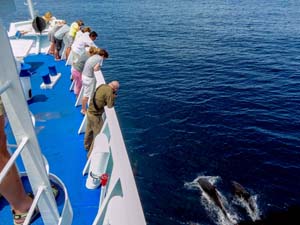
Every day we could walk up to birds and sea lions and other wildlife, as long as we didn’t scare them. The guides explained the regulations about not touching any bird or animal or picking up anything, rules strictly enforced.
Our interaction with wildlife also continued onboard the ship. On two occasions, the captain announced he had spotted dolphins. They turned out to be large pods, much larger than I had ever seen before, perhaps numbering in the hundreds.
After he steered towards them, they swam along with us, diving under the ship, going from side to side. Soon after, we came across a grey whale swimming lazily along.
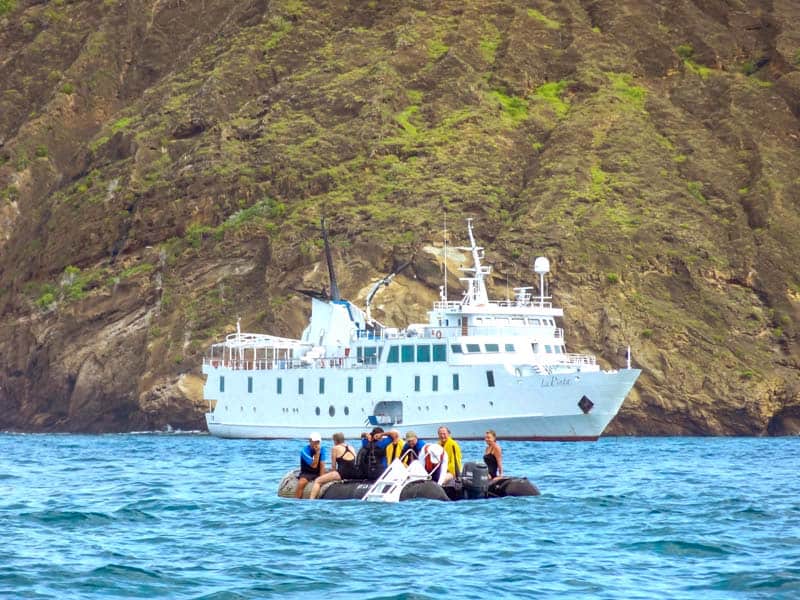
Cruising on La Pinta, a Comfortable Ship
For our Galapagos cruise vacation, we chose La Pinta, which is owned and operated by Metropolitan Touring, one of the largest touring companies in South America.
It’s a comfortable and modern 207’ ship that carries 48 passengers and 24 crew. It also has 3 naturalists aboard. It is a perfect size, large enough to ensure comfort and safety and small enough to provide an intimate experience.
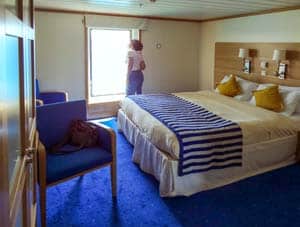
Luxury ships, such as La Pinta, and those mentioned above, provide you with a larger cabin. For example, our cabin on La Pinta was 189 ft.² (17.5 m²) with a shower and plenty of hot water, sometimes lacking on smaller vessels. Larger ships also provide better stability in rougher seas (vital if you’re prone to seasickness), better food, and have a doctor and medical facilities onboard.
Additionally, they often provide better guides/naturalists. Not only are the guides on larger ships more knowledgeable, but they usually also have a better command of the English language. It’s something that can be important if you’re not conversant in Spanish.

Island Excursions From Our Cruise Ship
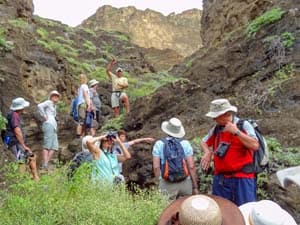
On every day of our Galapagos cruise vacation, we enjoyed good food, wine, and Wi-Fi. We spent the first two days in different areas around San Cristóbal and then moved on to Española Island. The ship normally repositioned itself at night or during a meal.
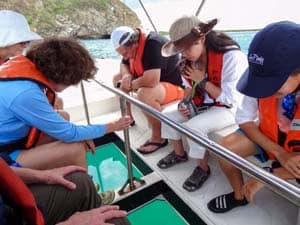
Our Galapagos vacation-day plans included morning and afternoon excursions, with lunch back on the ship. We could also spend an hour or two on an island beach most days, usually sharing the sand with a herd of sea lions after a short hike.
Everyone enjoyed the sea lions since the inquisitive juveniles would go into the water to play with you. At other times they’d just surf and tumble on the small waves along the shoreline.
All in all, we took three hikes during the cruise. The first was pretty easy across flat land into the bush, but the other two pushed the fitness envelope a bit.

One involved an hour’s hike up a gorge onto a plateau to see red-footed boobies and other birds. The other — to see blue-footed boobies, waved albatross, and marine iguanas — was across highly rocky terrain, which required walking sticks.
We spent another Galapagos cruise morning out on the water. Some of us snorkeled in the open sea off a Zodiac; others took a ride in a glass-bottom boat.
The four days were quite an experience for everyone. Being able to see rare species of birds and reptiles is, of course, thrilling. But seeing them in their natural surroundings in the wild is something you’ll never forget.
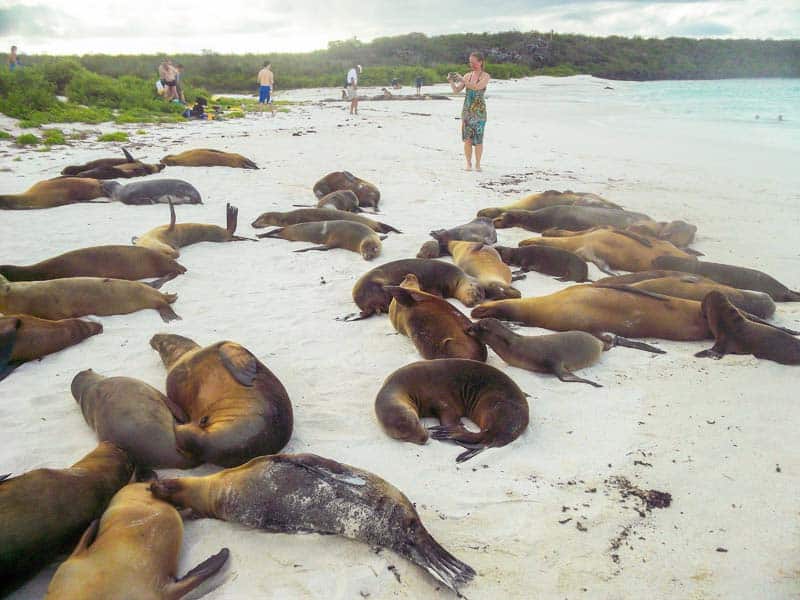
Some of the Animals You’ll See on a Galapagos Cruise
The sheer number and variety of wildlife both on land and in the water on a Galapagos cruise are pretty remarkable. Because of the islands’ isolation and remoteness, you find many of these species only in the Galapagos. And things there have not changed much since prehistoric times.
The Galapagos’ famous marine iguanas, albatross, and giant tortoises continue to amaze scientists and delight visitors to their world. And many unique species occur in significant concentrations. For example, marine iguanas bask on the beaches by the hundreds. On certain islands, you can see hundreds of birds at one time.
The following is a small sampling of some of the more popular animals you see on a Galapagos cruise vacation.
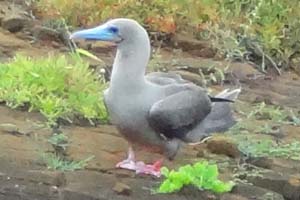
Red-footed Boobies
The Red-footed Boobies are one of the three species of Booby in the Galapagos. Their “booby” name comes from the Spanish word ‘bobo,’ meaning foolish or clown, and refers to their clumsy movement on land.
The are they are clumsy while taking off and landing, but are powerful and agile in flight.
The smallest of all booby species, Red-footed Boobies have distinctive red legs and feet and a pale blue bill.
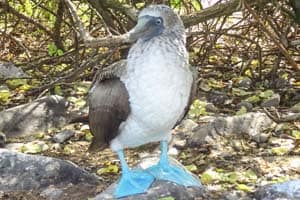
Blue-footed Boobies
The Blue-footed Boobies are large, distinctive birds found along the Eastern Pacific coastline of the islands.
Their plumage is brown on top, with their underparts white. They have large blue feet, which play an essential role in courtship. Each adult weighs about three-and-a half pounds, and has a five-foot wingspan.
Blue-footed Boobies are the most renowned birds in the Galapagos islands.
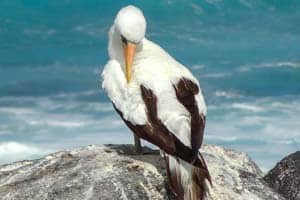
Nazca Boobies
The Nazca boobies can be differentiated by their gray feet color and orange beaks.
Galapagos Sea Lions
This is a species that primarily breeds on the Galapagos Islands. However, they are not ‘true’ seals, although they are the largest animals on the islands. Some males weigh 600 pounds.
Galapagos Penguins
The Galapagos Penguin is the most northerly occurring penguin species. That’s because the equator crosses the Galapagos on Isabela Island, where some colonies roost, which is in the Northern Hemisphere. Nesting only in the tropics, it is one of the smallest penguins in the world.
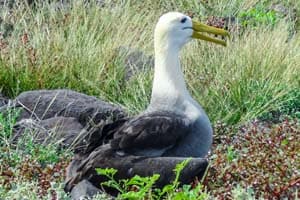
Waved Albatross
The Waved Albatross is the most giant bird in Galapagos. It gets its name from the wave-like pattern on the adults’ wings, which span more than eight feet (2.5 meters).
The are renown for their long, courtship dance and for mating for life.
Every January, however, the entire colony migrates to an area east of the Galapagos and the coasts between Colombia and Peru. There they raft of the ocean waters feeding on fish and squid for several months.
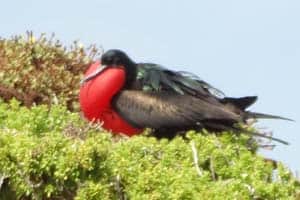
Magnificent Frigatebird
The male Magnificent Frigatebird has a very distinctive bright red throat pouch which it inflates to attract females. Interestingly, the female looks totally unlike the male, and has a white chest.
They are also known as Pirate Birds since they steal food from other birds in midair.
Both have the most significant wingspan-to-weight ratio of any bird. Because of its body shape, it can glide on thermals over the ocean for days at a time.
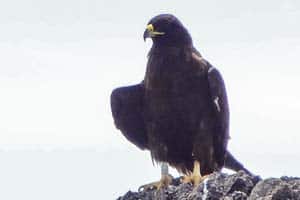
Galapagos Hawk
Closely related to North America’s red-backed and white-tailed hawks, the Galapagos Hawk is one of the world’s rarest raptors.
DNA analysis affirms it’s a relatively new arrival to the Galapagos, colonizing the Islands only 300,000 years ago.
While the males are entirely monogamous, females mate with numerous males (up to seven) throughout the nesting period. These males then help to raise the chicks. I would guess some say it’s the smartest bird in the world.
Adults are dark brown, with their plumage appearing almost black. It’s estimated there are only 150 breeding pairs left in the world.

Galapagos Giant Tortoise
The Galapagos Giant Tortoise is one of the most famous animals on the islands. In fact, it gave its name to them (Galapágo is an old Spanish word for tortoise).
It emigrated from the mainland to Galapagos 2-3 million years ago, where it diversified into 14 species. Unfortunately, only 12 species remain on the islands today.
One of the longest-lived vertebrates in the world, Giant Tortoises live to over 100 years in the wild and more than 170 years in captivity.
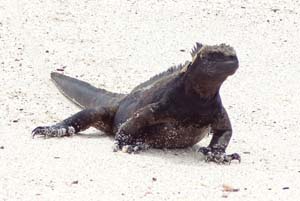
Marine Iguana
The Marine Iguana, the only black lizard in the world, can live and forage at sea.
Incredibly, there are six similar subspecies of this iguana in this relatively small area of the Galapagos, each on a different island. The species on Fernandina and Isabela are the largest.
Green Sea Turtle
A rarity in the world, the Galapagos Green Turtle is the most common species of green turtle on the Galapagos Islands and the only sea turtle to nest there.

Sally Lightfoot Crab
Brightly colored scavengers, Sally Lightfoot Crabs are rumored to have been named after a Caribbean dancer. They can jump across rocks as well as run in four directions. If disturbed, they will sometimes shed one of their legs as a defense mechanism (don’t worry, it grows back). You’ll see gazillions of them on seaside rocks all over the islands.
In addition, in the ocean surrounding the islands, you’ll find Spinner Dolphins, Humpback Whales, Orcas, Whale Sharks, Manta Rays, Sea Lions, etc.
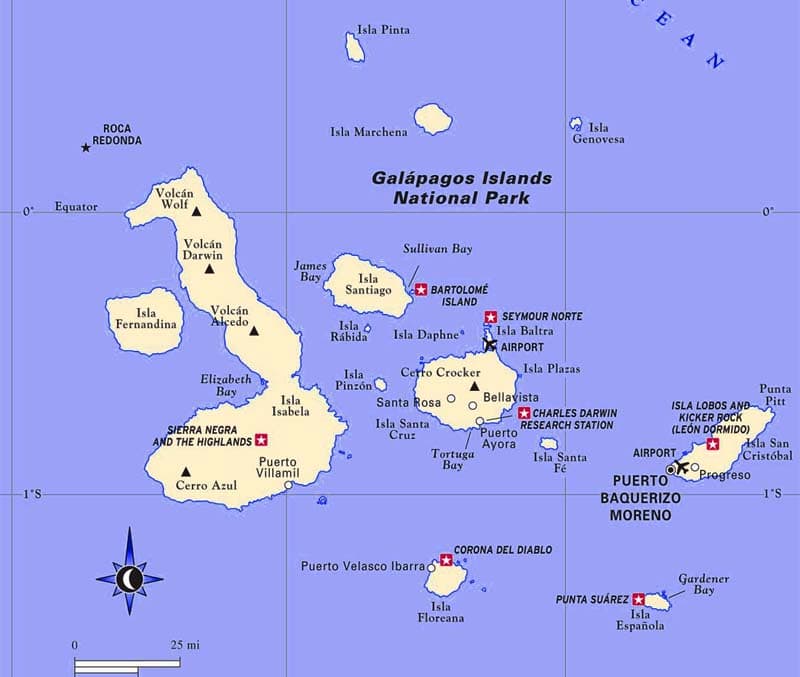
How to Get to the Islands and a Map of the Galapagos
There are no international flights to the Galapagos Islands and no ferry service from continental South America. Therefore, the only way to reach the Galapagos Islands is to first fly to Quito or Guayaquil on mainland Ecuador. From there, you board a connecting flight to the Galapagos islands, about a 2½-hour flight.
Most likely, you will need to overnight in Quito or Guayaquil before your Galapagos cruise vacation, so it may be good to spend a few days in either or both cities. We spent a week in Ecuador – a fascinating time – before flying on to the Galapagos.
In the Galapagos, you’ll arrive at one of two airports, one on the Island of Baltra, the other on San Cristobal. See the airports on the Galapagos Islands map above. Ensure you check with your cruise organizer or hotel as to which airport you should fly in to.

Requirements For Entering the Galapagos Islands
The following are required for all travelers, whether you’re only embarking on a Galapagos cruise vacation or staying in hotels and taking day trips entering the :
– A passport valid for more than 6 months.
– Proof of both health and travel insurance.
– A roundtrip flight ticket, which you will need to present at the airport.
– Health form (to be filled out upon your international arrival to Ecuador).
– A negative RT-PCR or antigen test issued within 72 hours at the moment of entering the Galapagos islands.
– Transit control card to the Galapagos, which is filled out and paid for at the airport before boarding your flight to Galapagos.
– Note: it is mandatory to use a face mask in all public places.
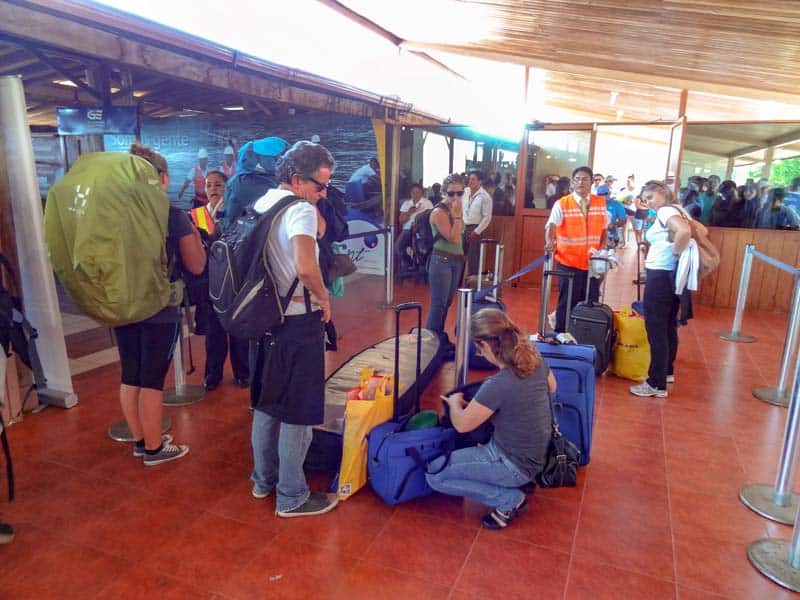
Arriving in the Galapagos
In addition to your passport, upon entering the Galapagos Islands it’s also necessary to present the INGALA transit card you were given at the airport in Quito or Guayaquil.
Our cruise vacation in the Galapagos began in the tiny airport on the island of San Cristóbal. Although you clear customs when you initially enter Ecuador, the process is repeated on your arrival in the Galapagos. That inspection ensures that no one brings seeds or plants onto the islands, which could quickly destroy the delicate environment.
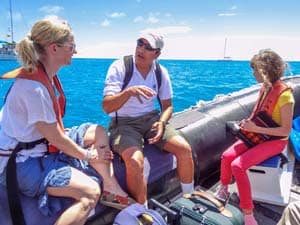
In the Galapagos, a park naturalist must accompany every group wherever they travel. Once through Customs, which seemed to take forever, we were collected by one of the naturalists assigned to our ship.
Even if you arrive aboard your own yacht, a naturalist will live-aboard with you while you’re in island waters. One guide, each responsible for protecting the park, is assigned to a maximum of 16 people.
Once out of customs, our guide herded us to a bus for the five-minute drive to the harbor. After walking past some snoozing sea lions on the small pier, we boarded Zodiac dinghies to ride out to the ship.
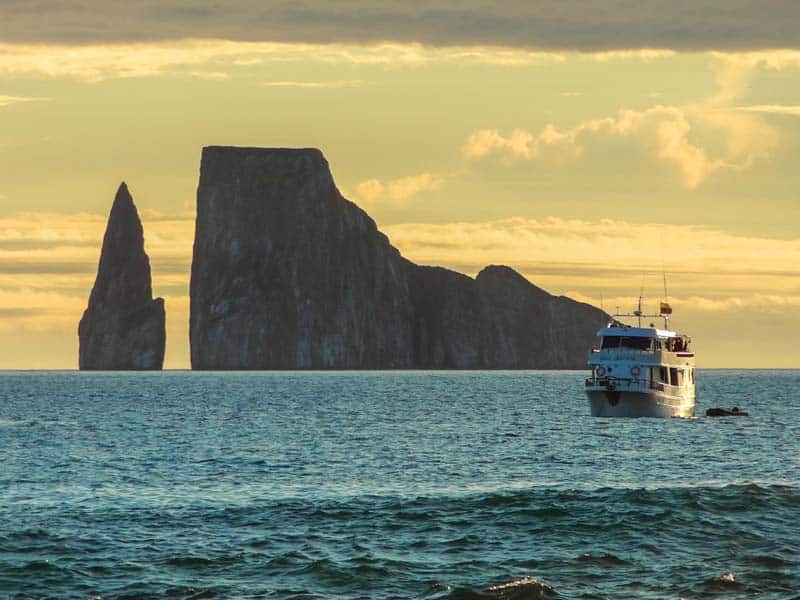
Ships and Types of Vessels Regulated
There’s no better way to cover ground on your trip to the Galapagos Islands than to sail aboard a cruise ship. Thankfully, the Galapagos National Park regulates the number and type of vessels allowed to operate in the area. This avoids overcrowding and also lessens the environmental impact. Take it from me; they’re doing a good job.
Galapagos National Park officials have also set a limit of 100-passengers per cruise ship. These limits minimize the stress on island animals. That’s why you won’t find mega-ships in the Galapagos, as you would in places such as the Caribbean.
Despite the absence of mega-ships, you will find some “household names” since cruise lines have adapted to the new rules. All cruise lines that offer Galapagos cruise vacations, however, are closely monitored by National Park officials.
Galapagos Cruises
Celebrity Cruises has three ships stationed in the Galapagos. The largest, the Celebrity Flora, is a 100-passenger ship built in 2019. During popular Christmas week, Celebrity’s cruises are more expensive, as you’ll find with most companies. It also offers 10- and16-night packages, which include a tour in Peru.
Celebrity’s other two ships are the 48-passenger Expedition and the 16-passenger Xploration, a catamaran.
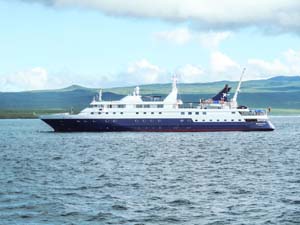
Lindblad/National Geographic has two ships in the Galapagos – the 48-passenger Islander and the 96-passenger Endeavor II with 52 outside cabins. The Endeavor II, initially built for 136 passengers, was scaled down to meet local requirements.
The Islander offers 7-day voyages in the Galapagos only and a 10-day package that includes a tour in Peru. The Endeavor II offers a 10-day cruise package in the Galapagos and a 16-day package with a Peru extension.
Silversea Cruises, an upscale cruise line, sails on 7-day cruises aboard its 100-passenger Silver Origin.
In 2022 the Norwegian cruise company Hurtigruten will enter the Galapagos market onboard the MS Santa Cruz II. Well-known for its polar-expedition adventures, it will be offering a 9-day package, including two days in Quito.
Live-aboard dive boats for those interested in scuba diving are also available. There are also yachts available in the Galapagos, some of which are used by the cruise lines mentioned above.
For example, UnCruise Adventures, a cruise company specializing in the US, Canada, and Mexico, has also expanded into the Galapagos-cruise-vacation market. It now also offers six-night Galapagos cruises aboard the luxury yacht La Pinta.
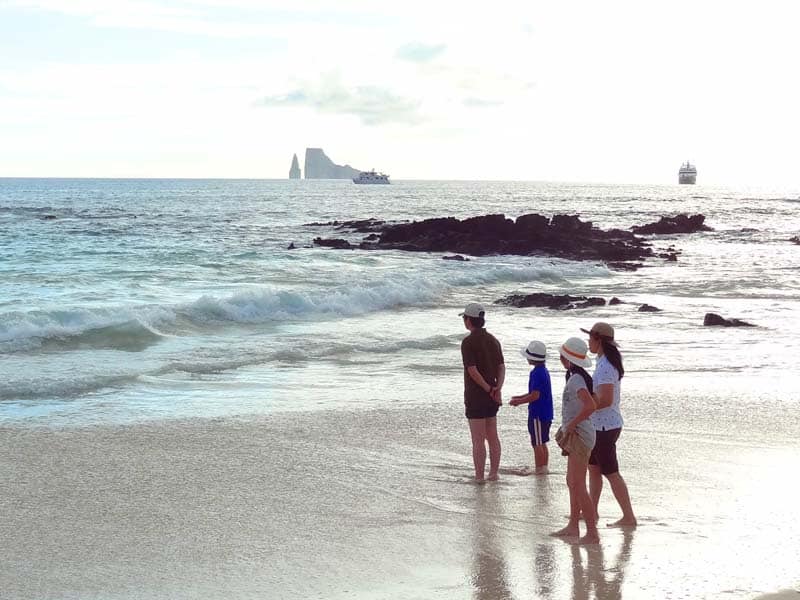
Best Time For a Galapagos Cruise
Basically, the warm and wet season in the Galapagos lasts from January to June. On the other hand, we visited the Galapagos in April and had perfect weather every day.
Conversely, June-November are the best months to go diving and snorkeling. It’s then the Humboldt current cools to wetsuit temperatures in the high 60s to low 80s, bringing in rich nutrients. It’s these nutrients that attract myriad underwater species. Many species of birds also mate from December to May.
Because of school vacations in the Northern Hemisphere, June-September are also popular months in the Galapagos. But the sea is also the roughest during June-November, so you may want to pack some seasickness medicine.
During popular times of the year – mid-December through mid-January, for example – you may have to book several months in advance.
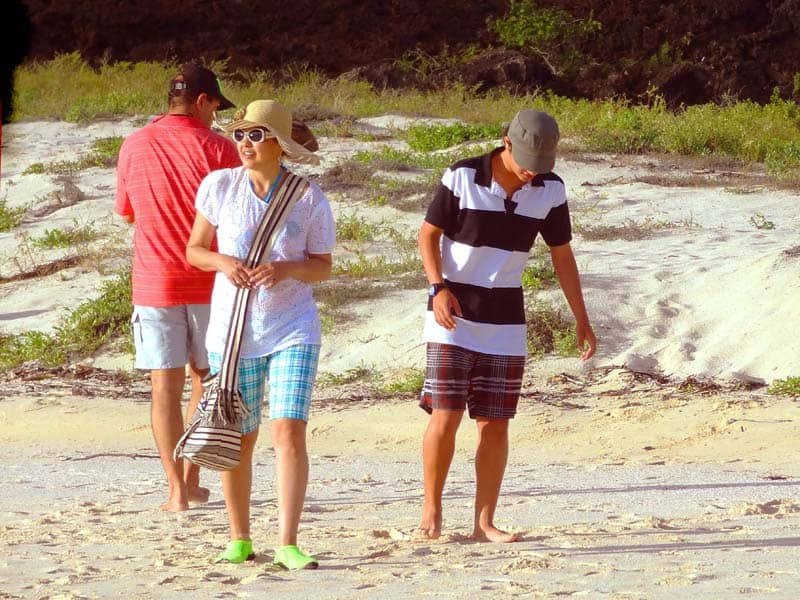
What to Wear
In addition to anything you’d normally wear on a cruise ship (although ship life is fairly casual during a Galapagos cruise vacation), you’ll want to bring the following.
Be aware that some island hikes can be strenuous if you’re not in good physical shape. Since some treks go up steep gorges or across very rocky ground, plan for your safety and comfort.
First of al, bring along some hiking boots/good walking shoes for daily walks, along with lightweight hiking socks.
You’ll also need Tevas, lightweight water-shoes perfect for climbing in and out of Zodiac dinghies on wet beach landings. I used my Tevas for both the water landing and the daily hikes and did not have a problem. It’s essential, however, to only wear the type that encloses your toes.
In addition to a bathing suit for the beach, you’ll also want shorts or lightweight pants for the hikes. And bring along both short- and long-sleeved shirts. Depending on the season, long sleeves may provide you the best protection from the sun.
Importantly, you’ll need to protect yourself from sunburn. Remember that you’ll be out on the ocean very near the equator, and the equatorial sun can be intense. Bring suntan lotion (SPF 70 and water-resistant) as well as bug spray. Just keep in mind the four-ounce liquid limitation on your airline.
Finally, plan on bringing all of the above from home. Keep in mind that you’ll be 600 miles from the nearest store, and you may not be able to purchase specific things in the Galapagos.
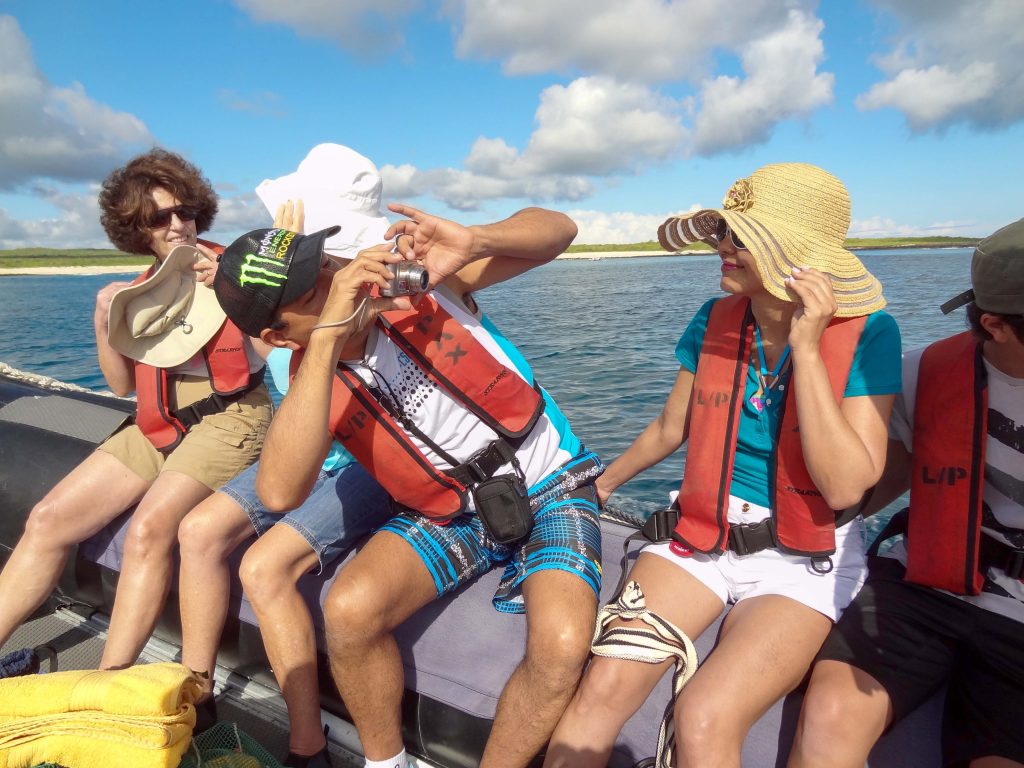
How Much Does A Galapagos Cruise Vacation Cost?
On a cruise vacation in the Galapagos, the primary expense is the ship. Even if you book a hotel and only take day trips, you’ll still need to take cruises to the islands. You can mitigate costs by booking a small ship or securing a last-minute deal. Some you can reserve online, others only after arrival in the islands.
Prices of cruises for the 2021/2022 season:
Celebrity Cruises:
Celebrity Flora: 7-night cruises range from $5,299 – 15,049pp (per person). (Celebrity’s more expensive cruises, as with most companies, are for popular Christmas week). It also offers 10- and16-night packages, which include a tour in Peru.
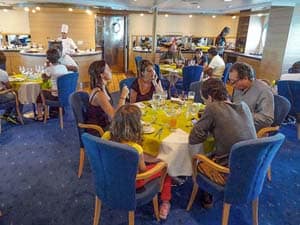
Lindblad/National Geographic:
The Islander’s rates range from $5,900pp (7 days in the Galapagos only) to $7,190pp (10 days, including a tour in Peru). The Endeavor II offers a 10-cruise package in the Galapagos from $7,560pp and a 16-day package that includes a Peru extension from $13,760pp.
Silversea Cruises:
Silver Origin offers a 7-day cruise for $11,650 – $13,650pp.
Hurtigruten:
In 2022 Hurtigruten’s MS Santa Cruz II will be offering a 9-day package, including two days in Quito. Prices will range from $8,417 to $9,630pp, the latter for a Christmas-week cruise.
UnCruise Adventures:
UnCruise Adventures offers 6-night Galapagos cruises aboard La Pinta one week per month, starting at $9,195pp. That price, however, includes a one-night pre-cruise hotel stay in Guayaquil, roundtrip airfare from Guayaquil to the Galapagos, and smaller group tours on the islands (12 people in a group rather than the allowable 16).
Metropolitan Touring:
Metropolitan Touring’s La Pinta offers a 4-night, 5-day cruise for $5,024pp and a 6-night, 7-day package for $6,732pp.
Unless noted, prices don’t include flight costs to Ecuador or to the islands from the mainland.
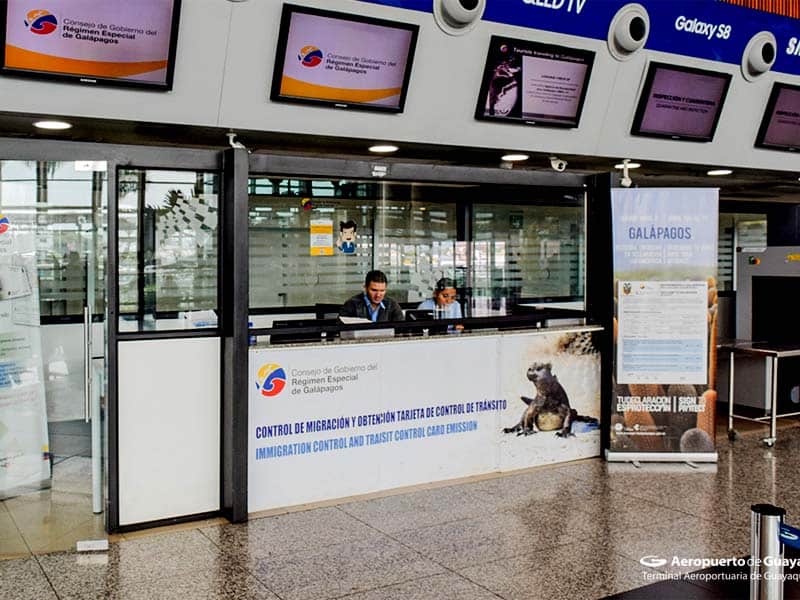
Additional Fees You’ll Be Charged
Before checking in for your flight to the Galapagos, you must purchase the Galapagos Transit Card. You’ll pay for it at the INGALA/CGREG counter at the airports in Quito or Guayaquil.
The cost is $20 per person, preferably paid in cash (it’s said the card machines don’t always work). If you’ve booked your cruise or tour through a travel agent, you’ve likely been pre-registered for the card.
In addition, on arrival in the Galapagos, a Galapagos Entrance Fee is charged. It is payable only in cash. The cost is $100 for each adult, $50 for each child under 12.
You may also enjoy: Photo Essay of the Galapagos, and Its Unique and Extraordinary Animal Species / Top Places To Visit in Ecuador / Things to Do in Cuenca, the Magical City in the Andes / Ecuador’s Fake Equator.
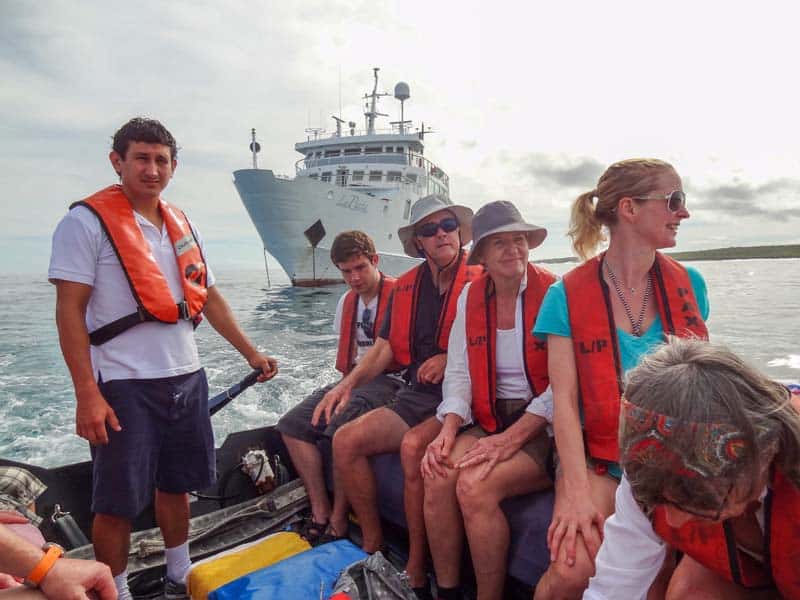
The Gratuity Issue
The final dilemma many people experience on cruises such as these is the gratuity problem. Just Google the subject, and you’ll see how many people are concerned with the issue. Although on some ships, gratuities are included in the cost of your cruise, on others, they’re not.
Before leaving home, I had researched the subject quite a bit. I found that the consensus was to provide $10 per passenger per day for the crew and $12 per passenger per day for the guide/naturalists. Pre-trip information from our tour operator, on the other hand, recommended $10 per person per day for the aggregate crew, plus $7 for the guide.
The night before we disembarked from La Pinta, however, a sheet providing schedule and departure information was left in each of our cabins. Included in the information was the subject of gratuities. It suggested $50 per guest (total, not per day) for the crew and $25 per guide/naturalist if you felt they had provided excellent service.
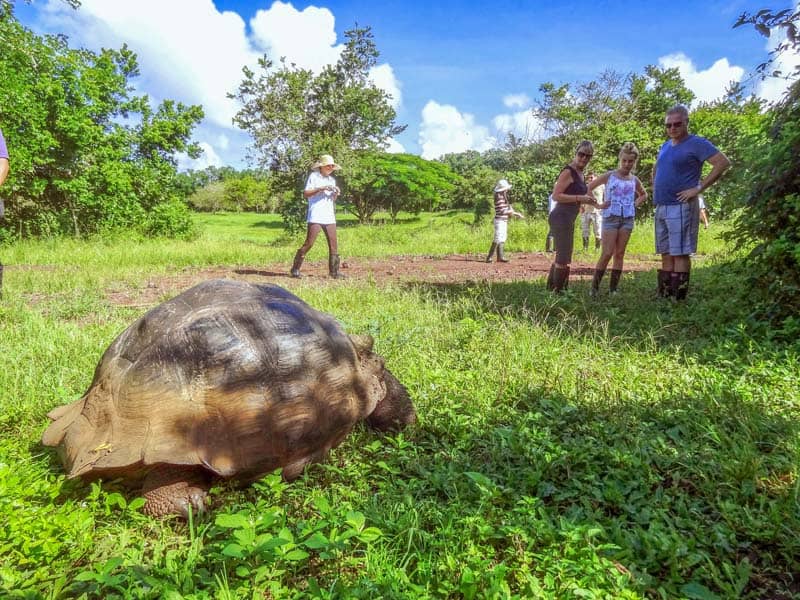
One Minor Disappointment
There was one disappointment on our Galapagos cruise vacation, however. Although it was listed in the itinerary from our travel agent, we never visited the Charles Darwin Research Station. It is the place where giant tortoises are being reared in captivity to save them from extinction.
Still, though, we did see one of the giants on the last day of the trip when we made a quick stop at a ranch en route to the airport. Startled when I walked up from behind, one made a loud hissing sound as it pulled its head into its huge shell upon my approach.
If You Go:
Celebrity Cruises
Miami, FL
Tel: (800) 647-2251
Lindblad/National Geographic
Washington, DC
Tel: (888) 966-8687
Silversea Cruises
Miami, FL
Tel: (888) 978-4070
Hurtigruten
Seattle, WA
Tel: (866) 552-0371
UnCruise Adventures
Seattle, WA
Tel: 888-862-8881
Metropolitan Touring
Quito, Ecuador
Tel: (855) 500-0496

Great article about the Galapagos.
We had a fantastic trip there in 2015 with Celebrity on Xpedition.
Our tips.
Toe covering water shoes
Sun hat with neck protector
Dry Bags to put camera in
Spare camera batteries and chargers
Waterproof camera. We got fantastic
pics while snorkeling
Listen to your guide and do everything that they tell you.
Finally, do not wear yellow. It attracts the Galapagos Wasp and from experience, I know their sting is painful!
Hi Ted – sounds that you had a great trip (although it’s hard not to in the Galapagos). I forgot all about not wearing yellow – thanks for reminding me.
This article totally reflects our experience. The Galapagos is definitely a must do trip for anyone who loves nature.
Thank you for helping me relive my experience.
Thank you Margarita. It sounds like you also had a wonderful trip!